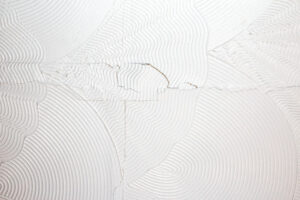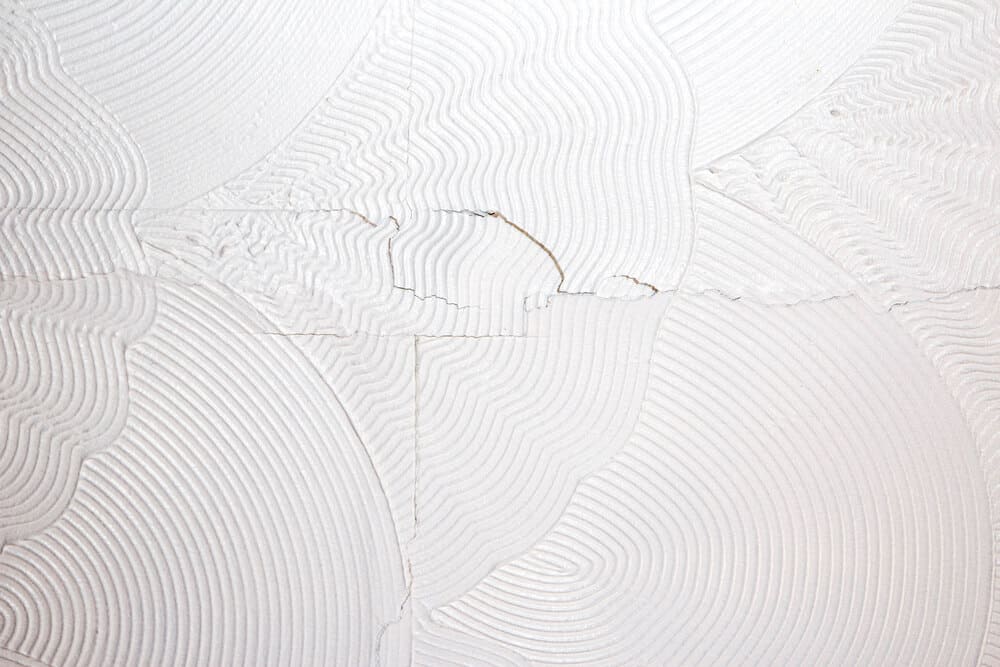How To Safely Remove Artex & How Dangerous Is it?
Asbestos was commonly used in ceilings up until the 1980s when its use was banned due to its health risks. If your property was built before this time, there is a good chance that original ceilings and walls artex could contain asbestos. You should always use a wet working removal system to remove artex as this prevents the dangerous asbestos dust particle from escaping into the air and being breathed in through your nose and mouth.
If you do have asbestos in your artex, ceiling or wall covering, it is important not to panic, as it’s only dangerous if you come in contact with the dust particles if it is disturbed. As long as the artex is in good condition and left undisturbed with no cracks, there is no risk to your health. If you need to remove or repair your artex ceiling, we would advise that you speak to a professional who has experience dealing with asbestos or you should use our wet working removal system X-Tex Artex Remover.
If you are looking to remove wall or ceiling coverings whether they contain asbestos or not, you can use Eco Solutions X Tex Artex Remover safely and without the worry of asbestos poisoning. X Tex uses a working wet system and this means whilst removing the wall or ceiling covering there will be no dangerous dust fibres as the covering always remains wet. Getting a professional in to remove ceiling and wall coverings containing asbestos can be tricky, to find someone as well as the costs of someone doing this for you in a safe way.
What is artex?
Artex or, wall or ceiling coverings used before the 1980s can contain asbestos, and as such, any dust particles can be extremely dangerous if inhaled. Artex was commonly used to cover ceilings and walls in the past, but its use has declined since the 1980s due to many health concerns and trends in interior design changing.
Artex does not always contain asbestos. The UK banned asbestos in wall and ceiling coverings in 1999, so any artex produced after this should be asbestos-free.
However, if your building was built or refurbished before 1999, then there’s a strong possibility that the artex could contain asbestos fibres. It was an incredibly popular material and easy to acquire 30 or so years ago, meaning it was used on a frequent basis. Most Artex wall and ceiling coverings made and applied before 1999 are likely to contain asbestos fibres. If the asbestos fibres become airborne and breathed in through your mouth or nose, it can lead to serious health problems, including lung cancer. While lung cancer is the most serious health concern associated with exposure to Artex, other issues such as mesothelioma and asbestosis can also occur. It is also worth noting that the effects of inhaling airborne particles don’t often become apparent until years and years after, sometimes 20 plus.
If you think you may have been exposed to Artex dust, it is important to see a doctor right away. Symptoms of asbestosis may not appear for years after exposure, so it is important to get checked out even if you do not feel unwell.
Is artex dust dangerous?
Artex is a type of decorative textured plaster which was popular in the 1970s and 1980s. It can be found on ceilings and walls in many homes built during that time period. Artex contains asbestos, which is a known carcinogen. When the plaster becomes damaged, it can release asbestos fibres into the air, where they can be breathed in by people and animals.
Exposure to asbestos has been linked to a number of serious health conditions, including lung cancer, mesothelioma (a type of cancer that affects the lining of the lungs or abdomen), and asbestosis (a chronic lung disease). Even low levels of exposure can cause these conditions. There is no safe level of exposure to asbestos — even brief exposure can be dangerous.
If you think you may have Artex in your home, it’s important to only remove it yourself using a wet working removal system like eco Solutions X Tex Artex Remover or contact a specialist to do it for you. Disturbing or removing Artex without using a wet working system can release asbestos fibres into the air, putting you and your family at risk for serious health problems.
The risk of asbestos in artex ceilings & walls
Asbestos was commonly used in Artex ceilings until the 1980s. If your home was built or refurbished before the 1990s, it’s likely that your Artex ceiling contains asbestos. Asbestos fibres can be released into the air when Artex is sanded or scraped, or if cracks appear which can pose a serious health risk if inhaled.
If you’re planning to renovate your home and need to remove an Artex or textured ceiling or wall, it’s important to have it tested for asbestos first or use a wet working removal system. Once removed, your ceiling will need to be sealed with an airtight material to prevent any more asbestos fibres from being released into the air.
How do you know if artex contains asbestos?
If you are unsure whether or not your artex ceiling contains asbestos, the best way to find out is to have it tested by a professional. There are DIY asbestos test kits available as well.
How much asbestos does artex contain?
When it comes to asbestos, Artex is the main brand name used and one of the most frequently mentioned products. But how much asbestos does Artex actually contain?
Asbestos is a naturally occurring mineral that has been used in many industrial and commercial applications due to its resistance to heat, chemicals, and electrical damage. However, exposure to asbestos can lead to several serious health problems, including lung cancer and mesothelioma.
The amount of asbestos in artex varies depending on the brand and age of the product. Some types of artex manufactured prior to 1980 may contain higher percentages of asbestos, while more modern products typically only contain trace amounts (less than 1%).
If you suspect that your home contains artex containing asbestos, it’s important not to panic. As long as the material is in good condition and not damaged or crumbling, there is no risk of exposure to the damaging dust particles that become air born. However, if you are planning on renovating or doing any work that would disturb the artex, it’s best to have it professionally removed by a licenced contractor or remove it using Eco Solutions X Tex Artex Remover which uses a safe wet working system for removal.
Are you at risk if your artex contains asbestos?
If your artex contains asbestos, you are only at risk of developing serious health problems if you have inhaled any dust particles that are omitted from it. Asbestos is a known carcinogen, and exposure to it can increase your risk of developing lung cancer, mesothelioma, and other diseases. If you are concerned that your artex may contain asbestos, you can have it tested by a qualified professional who will safely remove it and send it off to be tested. If the results come back positive for asbestos, you should take steps to remove the asbestos from your home or business to protect yourself and others from exposure if there are any cracks in the covering or if you are renovating a property.
Do you need a licenced contractor to remove artex?
This is a difficult question to answer as it depends on a number of factors. If the artex is in good condition and you simply want to remove it for aesthetic reasons, then you can do it yourself using a product like X Tex which uses a wet working system to remove it. However, if the artex is in poor condition or you are unsure about how to remove it safely, then you can hire a licenced and qualified contractor.
If you do decide to remove the artex yourself, there are a few things that you will need to bear in mind. Firstly, make sure that you protect any areas that you don’t want to be damaged by removing them or covering them with dust sheets or plastic sheeting. Secondly, use caution when removing any pieces of Artex as they may contain asbestos fibres, which can be harmful if inhaled if a wet working system is not used. Finally, once all the Artex has been removed, make sure that you thoroughly clean the area before painting or papering over it.
What does the law say about artex?
There is no specific legislation in the UK that covers Artex or textured coatings specifically. However, there are general laws and regulations that apply to all construction work, including the use of these products.
The Health and Safety Executive (HSE) provides guidance on their website about working with asbestos-containing materials (ACMs). This guidance applies to any type of ACM, including Artex. The HSE recommends that you assume any material containing asbestos is hazardous and take appropriate precautions.
If you think a material may contain asbestos, you should have it sampled and analysed by a qualified professional before undertaking any work on it.
Be aware when deciding to remove artex
Even small amounts of Artex can be harmful, so it is essential to take precautions when working with it. Artex containing asbestos can release harmful particles into the air, so it is vital to take precautions when working with it and if removing yourself always use a wet working system like Eco’s X Tex Artex Remover which is a safe and efficient product to use. You can protect yourself by; using X tex Artex Remover, wearing a respirator or mask and never sand or grind the artex, as this will release the dangerous asbestos particles into the air.
If your home was built before 2000, it’s important to have your artex tested for asbestos before attempting to remove it. If your Artex does contain asbestos fibres, you’ll need to take precautions when removing and painting it to avoid releasing dangerous particles into the air. Even if your Artex doesn’t contain asbestos, there are still some risks associated with painting it. The raised texture of Artex can make it difficult to apply the paint evenly, which can lead to an uneven finish. Paint also has a tendency to chip and flake off textured surfaces like Artex more easily than smooth surfaces.
Artex FAQ’s
Is peeling or cracked Artex dangerous?
 Artex is a type of textured ceiling finish that was popular in the 1970s and 80s. It is made from fine particles of asbestos, cement, and other materials. Artex can be found in many older homes and commercial buildings.
Artex is a type of textured ceiling finish that was popular in the 1970s and 80s. It is made from fine particles of asbestos, cement, and other materials. Artex can be found in many older homes and commercial buildings.
If the Artex is in good condition and well-sealed, it is not considered dangerous. However, if the Artex is old or damaged, microscopic asbestos fibres can be released into the air. These fibres can cause lung cancer and other serious health problems when inhaled.
If you suspect that your home or office has Artex on the ceilings, it is best to have it professionally tested by a qualified asbestos removal company before you attempt to remove it. If it contains does or doesn’t contain asbestos and you want to remove it yourself safely then always use a wet working system X Tex Artex Remover.
Does Artex devalue houses?
There is no easy answer to this question. On the one hand, some people argue that Artex can devalue a property because it can be difficult and expensive to remove, as well as people now want a more modern, smooth finish rather than swirls or bumps.
If you are planning on selling your property in the near future, it may be wise to consider removing it or having it tested for asbestos so you can be really clear with potential buyers. As soon as interested buyers see a patterned or raised wall of ceiling covering they will likely ask the question so always be prepared in advance.
However, if you love the look of your textured wall or ceiling covering and plan on staying in your home for many years, then enjoy the unique style it can add to your space.
Is it safe to paint Artex?
Artex is a type of textured party wall coating. It was created in the 1970s and became very popular in the 1980s due to its unique, raised patterns. Artex can be made from different materials, including plaster, cement, asbestos, or other fibres. Asbestos was commonly used in Artex up until the early 2000s when it was banned due to health concerns. Even though asbestos is no longer used in Artex, there are still some safety concerns about painting over Artex that contains asbestos fibres.
Before you paint your Artex, weigh the risks and benefits carefully. If you do choose to paint over your Artex, take measures to ensure that you do so safely and correctly for the best results possible and there are no damaged areas that could release airborne particles that are dangerous when inhaled by humans and animals.
In Summary
Remember, providing artex is in good condition, there is no risk to your health. If you are planning building work, or want to get your artex ceiling removed, you can get advice from an environmental health office, the HSE or asbestos specialists in order to safely plan the work and prevent accidental asbestos exposure.
Asbestos-related cancers and diseases can take years to develop, but when they do develop they are often fatal and there is no cure. So be safe, and be asbestos aware by using Eco Solutions X Tex Artex Remover which uses a safe wet working system to enable you to quickly and efficiently remove the coating yourself.
You can find out more about Eco Solutions X Tex Artex Remover and our other safe water-based, non-toxic cleaning and removal products here.

